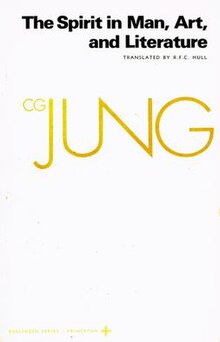Spirit in Man, Art, and Literature
Appearance

Spirit in Man, Art, and Literature, sometimes styled as The Spirit of..., is Volume 15 in The Collected Works of C. G. Jung, a series of books published by Princeton University Press in the U.S. and Routledge & Kegan Paul in the U.K. It contains nine essays, written between 1922 and 1941, on Paracelsus, Freud, Picasso, the sinologist Richard Wilhelm, Joyce's Ulysses, artistic creativity generally, and the source of artistic creativity in archetypal structures.[1]
Detailed abstracts of each chapter are available online.[2]
Carl Gustav Jung (1875-1961) developed analytical psychology and developed a radical new theory of the unconscious.[3]
See also
References
- Jung, C.G. (1966). Spirit in Man, Art, And Literature [sic], Collected Works of C.G. Jung, Volume 1, Princeton, N.J.: Princeton University Press. ISBN 978-0-691-09773-2
- Jung, C.G. (1967). The Spirit of Man in Art and Literature [sic], Collected Works of C. G. Jung, London: Routledge. ISBN 978-0-415-05168-2
- ^ "Collected Works of C.G. Jung, Volume 15: Spirit in Man, Art, and Literature". Princeton University Press. Retrieved 2014-01-20.
- ^ "Abstracts: Vol 15: The Spirit in Man, Art, and Literature". International Association for Analytic Psychology. Retrieved 2014-01-20.
- ^ "Collected Works of C.G. Jung". (Click on this book's title to see the details). Routledge. Archived from the original on 2014-01-16. Retrieved 2014-01-20.
